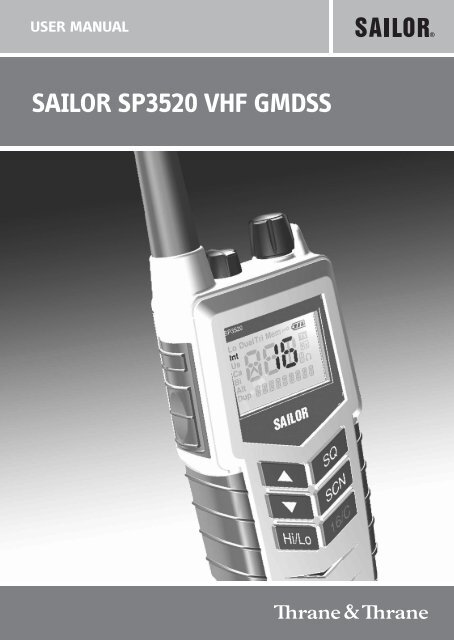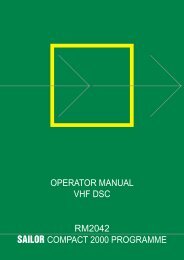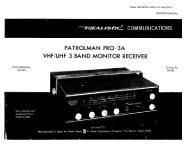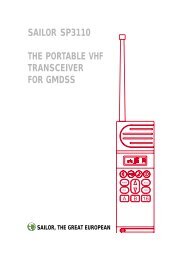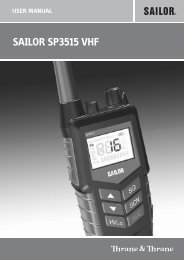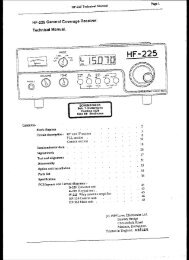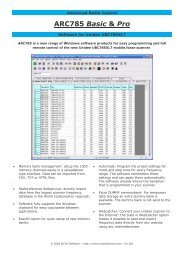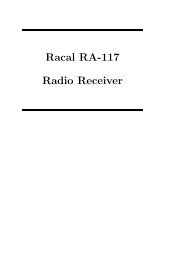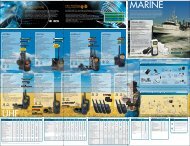SAILOR SP3520 VHF GMDSS
SAILOR SP3520 VHF GMDSS
SAILOR SP3520 VHF GMDSS
You also want an ePaper? Increase the reach of your titles
YUMPU automatically turns print PDFs into web optimized ePapers that Google loves.
USER MANUAL<br />
<strong>SAILOR</strong> <strong>SP3520</strong> <strong>VHF</strong> <strong>GMDSS</strong>
Emergency procedure<br />
• Remove the top-seal of the yellow emergency battery package.<br />
• Insert the battery package into the handheld transceiver.<br />
• Turn the knob at the top of the radio clockwise. The display lights<br />
up showing the last used channel and the battery level.<br />
• Select channel 16 (Distress or Safety), press the 16/C key.<br />
• Press the PTT and say:<br />
— “MAYDAY, MAYDAY, MAYDAY”,<br />
— “This is”..... ships name repeated three times<br />
—<br />
— “MAYDAY”<br />
— “This is”..... ships name and call sign,<br />
— The ship’s position in latitude and longitude or other reference<br />
to a known geographical location,<br />
— The nature of distress and assistance wanted,<br />
— Any other information which might facilitate the rescue.<br />
— “OVER”<br />
• Release PTT and listen for answer.<br />
0709
<strong>SP3520</strong> <strong>VHF</strong> <strong>GMDSS</strong><br />
Document number: TT 98-124294-D<br />
Release date: October, 2007<br />
Copyright: © 2007 Thrane & Thrane A/S. All rights reserved.<br />
Trademark Acknowledgements<br />
• <strong>SAILOR</strong> is a registered trademark of Thrane & Thrane A/S.<br />
• Other product and company names mentioned in this manual may be<br />
trademarks or trade names of their respective owners.<br />
Warranty limitation<br />
IMPORTANT - The radio is a sealed waterproof unit. To create and maintain its<br />
waterproof integrity it was assembled in a controlled environment using special<br />
equipment. The radio is not a user maintainable unit, and under no circumstances<br />
should the unit be opened except by authorized personnel. Unauthorized opening<br />
of the unit will invalidate the warranty.<br />
Disclaimer<br />
Any responsibility or liability for loss or damage in connection with the use of this<br />
product and the accompanying documentation is disclaimed by Thrane & Thrane.<br />
The information in this manual is provided for information purposes only, is<br />
subject to change without notice, may contain errors or inaccuracies, and<br />
represents no commitment whatsoever by Thrane & Thrane. This agreement is<br />
governed by the laws of Denmark.<br />
Manuals issued by Thrane & Thrane are periodically revised and updated. Anyone<br />
relying on this information should satisfy himself/herself as to the most current<br />
version. Providers with access to Thrane & Thrane's Extranet may obtain current<br />
copies of manuals at: http://extranet.thrane.com<br />
Thrane & Thrane is not responsible for the content or accuracy of any translations<br />
or reproductions, in whole or in part, of this manual from any other source.<br />
0740<br />
i
Precautions<br />
Avoid water and salt in the I/O connector and keep it<br />
clean frequently.<br />
Only use original Thrane & Thrane battery packs. Make<br />
sure they are clean and dry before attaching the<br />
transceiver. Be careful not to damage any gaskets.<br />
Only use the original Thrane & Thrane charger for the<br />
rechargeable battery.<br />
Be very careful when handling the Lithium batteries.<br />
With correct use they are safe but any misuse might<br />
cause dangerous situations.<br />
Never short circuit the battery terminals, never expose<br />
the transceiver and the batteries to extreme temperature<br />
or fire and never use any kind of violence.<br />
Avoid close contact between the antenna and parts of<br />
the human body. The top of the antenna must never be<br />
closer than 5 cm to the body when transmitting.<br />
Do not submerge the transceiver more than 1 m for 30<br />
minutes.<br />
Keep the transceiver at least 0.3 m away from the<br />
magnetic compass.<br />
ii<br />
0709
Training information<br />
<strong>SAILOR</strong> <strong>SP3520</strong> <strong>VHF</strong> <strong>GMDSS</strong> is designed for "occupational use only". It must be<br />
operated by licensed personnel only.<br />
The <strong>SP3520</strong> complies with the FCC RF exposure limits for "Occupational Use Only".<br />
• FCC OET Bulletin 65 Supplement C, evaluating compliance with FCC guidelines<br />
for human exposure to radio frequency electromagnetic fields.<br />
• American National Standards Institute (C95.1) IEEE standard for safety levels<br />
with respect to human exposure to radio frequency electromagnetic fields,<br />
3 kHz to 300 GHz.<br />
• American National Standards Institute (C95.3) IEEE recommended practice for<br />
the measurement of potentially hazardous electromagnetic fields - RF and<br />
microwaves.<br />
Warning! Your Thrane & Thrane <strong>VHF</strong> radio generates<br />
electromagnetic RF (radio frequency) energy when<br />
transmitting. To ensure that you are not exposed to excessive<br />
amounts of energy and thus to avoid health hazards from<br />
excessive exposure to RF energy, all persons must be at least 5<br />
cm away from the antenna when the radio is transmitting.<br />
Correct use<br />
For best performance, hold the radio vertically and 10 cm away from the head<br />
when talking into the microphone.<br />
0703<br />
iii
iv 0641
Contents<br />
Chapter<br />
Chapter<br />
Chapter<br />
Introduction<br />
Your <strong>VHF</strong> <strong>GMDSS</strong> .................................................................1<br />
Performance .......................................................................2<br />
Channels ............................................................................2<br />
Operation<br />
Controls ..............................................................................3<br />
Keys and buttons ................................................................3<br />
The display .........................................................................5<br />
Using the <strong>VHF</strong> <strong>GMDSS</strong> ........................................................6<br />
Basic functions ...................................................................6<br />
Other functions ...................................................................9<br />
Configuring the <strong>VHF</strong> <strong>GMDSS</strong> ..............................................10<br />
Entering and using configuration mode ............................10<br />
Configuration settings ....................................................... 11<br />
Batteries<br />
Battery types .....................................................................13<br />
The primary battery ...........................................................13<br />
The secondary battery .......................................................14<br />
Battery level indication ......................................................14<br />
Removing and inserting the battery pack ...........................14<br />
The battery charger ...........................................................15<br />
Installing the charger ........................................................15<br />
Recharging the secondary battery .....................................16<br />
0643<br />
v
Chapter<br />
Chapter<br />
App.<br />
App.<br />
Equipment and accessories<br />
External equipment ...........................................................17<br />
List of equipment ...............................................................17<br />
Connecting external equipment .........................................17<br />
Impact on radio operation .................................................18<br />
Accessorie connector .........................................................18<br />
Accessories .......................................................................19<br />
List of accessories ..............................................................19<br />
Attaching and removing the belt clip .................................21<br />
Attaching the lanyard ........................................................21<br />
Troubleshooting<br />
Displaying errors .............................................................. 23<br />
Technical specifications<br />
Technical data <strong>SP3520</strong> ..................................................... 25<br />
General ............................................................................ 25<br />
Transmitter ....................................................................... 26<br />
Receiver ........................................................................... 26<br />
Battery life guidelines ...................................................... 27<br />
Primary battery (non-rechargeable) ................................. 27<br />
Secondary battery (rechargeable) ..................................... 27<br />
Dimensional drawing, transceiver .................................... 28<br />
Dimensional drawing, chargers ....................................... 29<br />
Attention<br />
Goretex Membran .............................................................31<br />
vi<br />
0740
Chapter 1<br />
Introduction<br />
Your <strong>VHF</strong> <strong>GMDSS</strong><br />
<strong>SP3520</strong>, your new <strong>SAILOR</strong> portable <strong>VHF</strong><br />
transceiver, is approved to fulfil the <strong>GMDSS</strong><br />
requirements for portable <strong>VHF</strong> radios for Safety at<br />
Sea and is waterproof to the IP67 standard.<br />
As part of the required safety equipment, the<br />
<strong>SAILOR</strong> <strong>SP3520</strong> is to be used in an emergency<br />
situation. However the best way to guarantee<br />
functionality in an emergency situation, is to use<br />
the radio in daily communication on board.<br />
The <strong>SP3520</strong> is designed for daily use and it<br />
connects easily to external equipment like<br />
headsets and fist mikes, making the <strong>SP3520</strong><br />
suitable for any noisy environment.<br />
The unique battery concept makes the radio<br />
suited for both daily use and emergency<br />
situations. The primary emergency battery is to<br />
be stored for emergency situations and a<br />
secondary rechargeable battery can be used for<br />
daily communication in your new portable <strong>VHF</strong><br />
transceiver.<br />
The radio is designed with a unique man<br />
machine interface, an excellent grip even with<br />
gloves, and large tactile buttons.<br />
0641<br />
1
Introduction<br />
The display has red adjustable backlight which makes the display visible<br />
even at night.<br />
The radio is equipped with a lanyard and a belt clip. A huge accessory<br />
program comes with the <strong>SAILOR</strong> SP3500 series.<br />
Please find the nearest <strong>SAILOR</strong> distributor on www.thrane.com.<br />
Performance<br />
For best performance of the transceiver keep the following in mind:<br />
• Keep clear of metal environment.<br />
• Hold the transceiver vertically and 10 cm from lips and push the PTT<br />
when transmitting.<br />
• In receive mode carry the transceiver vertically with belt clips.<br />
• To preserve battery power, adjust squelch to close the loudspeaker<br />
when there is no signal.<br />
• If you are in a lifeboat keep the antenna as high as possible.<br />
Channels<br />
This radio operates with the following channels:<br />
6 11 15 68 73 77<br />
8 12 16 69 74 87<br />
9 13 17 71 75 88<br />
10 14 67 72 76<br />
Notes:<br />
• All channels are Simplex.<br />
• Tx power is limited to 1 W on<br />
channels 75 and 76.<br />
2<br />
0703
Chapter 2<br />
Operation<br />
Controls<br />
Keys and buttons<br />
1. On/off/volume<br />
2. Light/Lock<br />
3. Push To Talk (PTT)<br />
4. Up key<br />
5. Down key<br />
6. Hi/Lo output power<br />
7. Squelch<br />
8. Scan<br />
9. Priority channel (16)/<br />
Call channel<br />
10. Loudspeaker/microphone<br />
2<br />
3<br />
4<br />
5<br />
6<br />
1<br />
7<br />
8<br />
9<br />
10<br />
0740<br />
3
Operation<br />
Key presses<br />
Pressing and holding certain keys gives access to additional functions,<br />
shown in the table below.<br />
Key<br />
Short press<br />
(1 beep)<br />
Long press<br />
(2 beeps)<br />
Extra long<br />
press<br />
(3 beeps)<br />
Show next available<br />
item in the list (up or<br />
down).<br />
Default: Channel<br />
selection<br />
Run through available<br />
items, or<br />
select tagged channels<br />
A () or B ().<br />
Run through<br />
available<br />
items if an A<br />
or B channel<br />
is tagged<br />
Activate Squelch<br />
control (Adjust with<br />
up/down arrows).<br />
Monitor function. Open<br />
Squelch completely.<br />
1 press: Activate/<br />
terminate Dual/Triple<br />
watch.<br />
Add/Delete channel<br />
from memory scan.<br />
2 presses: Activate<br />
memory scan.<br />
Toggle between high<br />
and low transmitter<br />
power.<br />
Select channel 16.<br />
Select programmed<br />
Call channel.<br />
Program Call<br />
channel.<br />
4<br />
0703
Operation<br />
The display<br />
The display holds various fields of information, explained below.<br />
4 5 6<br />
3<br />
2<br />
1<br />
7<br />
8<br />
9<br />
10<br />
1. Current working channel.<br />
2. Current channel mode.<br />
3. “Lo”: Reduced transmitter power.<br />
Full transmitter power is not shown in display.<br />
4. Dual watch activated.<br />
5. Current working channel is marked for scanning.<br />
6. Keypad is locked.<br />
7. Battery level indicator.<br />
8. Transmitting (Tx) /Receiving (Rx).<br />
9. Accessory is connected.<br />
10. Service line for various purposes. In this example the volume level.<br />
0643<br />
5
Operation<br />
Using the <strong>VHF</strong> <strong>GMDSS</strong><br />
Basic functions<br />
Note<br />
Before using the radio, mount the antenna at the top of the<br />
radio. The antenna is delivered with the radio.<br />
Switching the radio on and off<br />
• To switch the radio on, turn the knob at the top<br />
of the radio clockwise.<br />
The display lights up showing the last used<br />
channel and the battery level.<br />
• To switch the radio off, Turn the knob back<br />
counter-clockwise until it clicks.<br />
Selecting the working channel<br />
• To select channel 16 (Distress or Safety), press the 16/C key.<br />
• To select the Call channel, use a long press on 16/C.<br />
• To select among all available channels, press or on the keypad.<br />
For fast selection, press and hold or .<br />
The display shows the currently selected channel.<br />
Note<br />
Long press on or can also be used to select preferred<br />
channels. For information on how to program preferred<br />
channels, see Configuring the <strong>VHF</strong> <strong>GMDSS</strong> on page 10.<br />
6<br />
0643
Operation<br />
Activating a call<br />
To activate a call to the selected channel, press and<br />
hold the PTT button on the side of the radio.<br />
The radio transmits as long as the PTT button is<br />
pressed. A small Tx sign next to the channel number<br />
indicates when the radio is in transmit mode.<br />
Adjusting the volume<br />
• To increase the volume, turn the on/off knob at the top of the radio<br />
clockwise.<br />
• To decrease the volume, turn the knob counter-clockwise.<br />
The display shows the level of the volume, e.g. “VOL 5”, while it is<br />
adjusted.<br />
Using Squelch control<br />
• To activate Squelch control, press the SQ key.<br />
• To set the Squelch level, press (closing) or (opening). The<br />
display shows the Squelch level while it is adjusted, e.g. “SQ 5”.<br />
Adjusting the display backlight<br />
• To turn on the backlight, press the<br />
Light/Lock button on the side of the radio.<br />
• To adjust the backlight level, press or <br />
within 3 seconds after turning on the light.<br />
The display shows the level while it is<br />
adjusted, e.g. “DIM MED”.<br />
0643<br />
7
Operation<br />
Using Dual watch<br />
To activate Dual watch, press the SCN key.<br />
The display shows “Dual” at the top and “16” at the bottom right.<br />
The radio toggles between the selected channel and channel 16.<br />
• To terminate Dual watch, press SCN again.<br />
Scanning channels<br />
• To activate scanning memory, press 2 times SCN within 2 seconds.<br />
During scanning, the display shows “SC” in the channel field. The<br />
radio toggles between channel 16 and each of the channels marked<br />
for scanning.<br />
• To terminate scanning, press SCN once.<br />
Changing the transmitter power<br />
To change the transmitter power, press the Hi/Lo key. The display shows<br />
“Lo” when power is set to low. Otherwise maximum power is used.<br />
Locking the keypad<br />
• To lock the keypad, press and hold the Light/Lock button. The display<br />
shows a key symbol when the keypad is locked.<br />
• To unlock the keypad, press and hold the Light/Lock button again.<br />
8<br />
0740
Operation<br />
Other functions<br />
Programming the Call channel<br />
To program the Call channel, do as follows:<br />
1. Press and hold 16/C until the current Call channel number is flashing.<br />
2. Select the channel with or .<br />
3. Press 16/C to confirm.<br />
Programming the scanning memory<br />
To add a channel to the scanning memory, select the channel and then<br />
press and hold the SCN key until the display shows MEM at the top.<br />
To remove a channel from the scanning memory, select the channel and<br />
then press and hold the SCN key until the MEM sign disappears from the<br />
display.<br />
0740<br />
9
Operation<br />
Configuring the <strong>VHF</strong> <strong>GMDSS</strong><br />
Entering and using configuration mode<br />
Note<br />
The radio is not operational in configuration mode.<br />
• To enter configuration mode, press and hold the Light/Lock button<br />
while turning on the radio.<br />
The bottom line of the display shows the current menu item/setting.<br />
• To exit configuration mode, turn off the radio or press any key except<br />
, and the Light/Lock button.<br />
Using the PTT button or leaving the radio inactive for 10 seconds also<br />
causes the radio to exit configuration mode.<br />
• To change a setting, press or .<br />
• To confirm the current setting and go to the next menu item, press the<br />
Light/Lock button.<br />
10<br />
0643
Operation<br />
Configuration settings<br />
Configuration mode is used to program preferred channels and volume of<br />
key beep and battery alarm.<br />
The following settings are available in configuration mode.<br />
BEEP MAX Status click/beep sound on key press, long<br />
press (settings/programming saved) and<br />
battery alarm. Maximum level.<br />
MIN<br />
OFF<br />
Status click/beep sound on key press, long<br />
press (settings/programming saved) and<br />
battery alarm. Minimum level.<br />
All beeps off.<br />
PREFA OFF Remove tag “A” for current working channel.<br />
ON<br />
Tag current working channel with “A”. If<br />
another channel was previously tagged “A”,<br />
this is overruled.<br />
• The working channel can now be selected<br />
with a long press on .<br />
PREFB OFF Remove tag “B” for current working channel.<br />
ON<br />
Tag current working channel with “B”. If<br />
another channel was previously tagged “B”,<br />
this is overruled.<br />
• The working channel can now be selected<br />
with a long press on .<br />
VER X.XX.XX Software version. Read-only.<br />
0703<br />
11
Operation<br />
12 0643
Chapter 3<br />
Batteries<br />
Battery types<br />
• The yellow primary battery pack contains a non-rechargeable Lithium<br />
battery. This battery pack is only to be used in case of emergency.<br />
• The black secondary battery pack contains a rechargeable battery.<br />
This battery pack is for daily use.<br />
The primary battery<br />
Important<br />
The yellow primary battery pack is only for emergency use,<br />
and is not rechargeable.<br />
Before using the primary battery, remove the seal on the battery pack.<br />
Then do as follows:<br />
1. Attach the battery pack to the radio as<br />
shown.<br />
2. Lock the battery with the safety lock at the<br />
bottom.<br />
The primary battery is capable of providing<br />
sufficient power for 8 hours of operation defined<br />
as 10% Tx, 10% Rx and 80% standby.<br />
When the primary pack is not in use it must<br />
always be placed in the dedicated rear position<br />
in the charger cradle, see The battery charger on<br />
page 15.<br />
2<br />
1<br />
0709<br />
13
Batteries<br />
The secondary battery<br />
Battery level indication<br />
The black secondary battery pack is for daily use of the radio. When the<br />
battery level is low, you should recharge the battery.<br />
The radio display shows the battery<br />
status. When the battery symbol is empty<br />
and flashing, the battery should be<br />
recharged as soon as possible.<br />
Removing and inserting the battery pack<br />
To remove the battery pack, do as follows:<br />
1. Open the safety lock as shown.<br />
2. Remove the battery.<br />
To insert the battery pack, attach the battery<br />
and close the safety lock as shown on the<br />
previous page.<br />
2<br />
1<br />
14<br />
0643
Batteries<br />
The battery charger<br />
The chargers has two compartments.<br />
CH3507<br />
• A rear compartment only for<br />
storing a spare battery. It does not<br />
have a charger function.<br />
• A front compartment for<br />
recharging the battery alone or<br />
while attached to the radio.<br />
CH3508<br />
• It is possible to charge a battery in<br />
rear compartment simultaneously<br />
with the radio/battery in front.<br />
Installing the charger<br />
Mounting the charger<br />
There are several options for<br />
mounting one or more chargers on a<br />
table or a wall.<br />
For information on dimensions and<br />
screw positions, refer to Dimensional<br />
drawing, charger on page 27.<br />
When mounting the charger, make<br />
sure it is placed in a dry place and<br />
away from direct sunlight. The<br />
charger is not waterproof.<br />
0740<br />
15
Batteries<br />
Connecting to power<br />
The charger can be supplied with DC or AC.<br />
DC: Connect the 12-24VDC Connection Cable between the DC supply and<br />
the connector on the underside of the charger.<br />
AC: Connect the AC/DC adapter to the connector on the underside of the<br />
charger. Then connect the AC/DC adapter to the AC outlet.<br />
Recharging the secondary battery<br />
Important<br />
Do not attempt to recharge the yellow primary battery!<br />
To recharge the secondary battery, place the radio 1 with battery or the<br />
battery alone in the front position of the charger cradle.<br />
The light indicators on the charger cradle show the status as follows:<br />
• Green light: Power is connected to the charger.<br />
• Slow red flash: Charging in progress.<br />
• Quick red flash (twice per second): Charging error, e.g. battery<br />
defect or temperature out of range.<br />
• Steady red light: Charging completed. Trickle charge mode.<br />
Charging time with emtpy battery: <strong>VHF</strong> off<br />
approx. 4 hours, <strong>VHF</strong> on: approx. 5 hours.<br />
The battery indicator on the radio display<br />
indicates if the radio is placed in the<br />
charger while radio and charger are both<br />
powered.<br />
16<br />
1. The radio may be left on or it may be switched off during the recharge<br />
process.<br />
0740
Chapter 4<br />
Equipment and accessories<br />
External equipment<br />
List of equipment<br />
The following equipment can be connected to the radio:<br />
• SAVOX 400E Push-To Talk unit<br />
• SAVOX C500 Fist Mike<br />
• SAVOX NC/400 Noise-com<br />
• SAVOX HC-E Helmet-com<br />
• SAVOX K53004 Helmet unit<br />
• Peltor MT7H79 Headset<br />
We recommend to remove all accessories during emergency use.<br />
All accessories listed might be used when body worn.<br />
Connecting external equipment<br />
Connect the dedicated interface cable between the external equipment<br />
and the top connector on the radio.<br />
Interface cable<br />
Order number<br />
For SAVOX 400E 403500-940<br />
For SAVOX C500 403500-950<br />
For Peltor FL5061 403500-951<br />
0740<br />
17
Equipment and accessories<br />
When external equipment is connected<br />
to the radio, the right side of the display<br />
will show a headset.<br />
Impact on radio operation<br />
The external equipment can have a built-in PTT, speaker and<br />
microphone. Thus connecting it to the radio will have the following<br />
impact on the radio operation:<br />
• If a microphone is built into the detected external equipment, the<br />
external equipment microphone is used, and the internal radio<br />
microphone is disabled.<br />
• If a speaker or earpiece is built into the detected external equipment,<br />
the external equipment sound device is used, and the internal radio<br />
speaker is disabled.<br />
• If a PTT or VOX is built into the detected external equipment, the<br />
external equipment PTT control is used, and the radio PTT button is<br />
disabled.<br />
Accessorie connector<br />
Pin 1. Loudspeaker,<br />
minimum 8 ohm impedance.<br />
Pin 2. Accessory power,<br />
5V maximum 0.03A.<br />
Pin 3. Microphone input,<br />
Ri = 2.2kohm, 3V phantom power.<br />
Pin 4. GND<br />
18<br />
0740
Equipment and accessories<br />
Accessories<br />
List of accessories<br />
The following accessories are delivered with your radio:<br />
Accessory<br />
Primary battery (yellow, non-rechargeable), B3501<br />
Secondary battery (black, rechargeable), B3502<br />
Charger, CH3507<br />
Part number<br />
403501A<br />
403502A<br />
403507A<br />
AC/DC converter, length 150cm (100-240V~ /12VDC out) 88-125538<br />
12-24VDC Connection cable, length 150cm 37-124381<br />
Belt clip 62-124320<br />
Antenna 88-124370<br />
Lanyard 41-124375<br />
<strong>SP3520</strong> User Manual (this manual) 98-124294<br />
Batteries, charger, AC/DC Converter and 12VDC Connection are described<br />
in Batteries on page 13.<br />
To mount the antenna, simply screw it into the threaded bush at the top<br />
of the radio.<br />
Use of lanyard is only for hand held operation. Put it around the wrist to<br />
prevent dropping the radio.<br />
0740<br />
19
Equipment and accessories<br />
Accessories you may buy<br />
Dual Position Charger CH3508<br />
Accessory<br />
Part number<br />
403508A<br />
Leather Case 403500-205<br />
Leather Case<br />
Warning!<br />
The display must always be kept away from the body to reduce the RF<br />
exposure when body worn.<br />
20<br />
0740
Equipment and accessories<br />
Attaching and removing the belt clip<br />
To attach the belt clip, slide the belt clip upwards<br />
into the rails at the back of the radio until it locks.<br />
To remove the belt clip, press the projection at<br />
the top of the belt clip to release the lock and<br />
slide the belt clip downwards out of the rails.<br />
Release lock<br />
Attaching the lanyard<br />
Do as follows:<br />
1. Take the lanyard through the<br />
eye at the top of the radio.<br />
2. Put one end of the lanyard<br />
through the loop at the other<br />
end of the lanyard and pull to<br />
tighten.<br />
0740<br />
Top view<br />
21
Equipment and accessories<br />
22 0740
Chapter 5<br />
Troubleshooting<br />
Displaying errors<br />
Some errors result in an error message in the display. These error<br />
messages are listed below.<br />
Display text Problem Type Actions<br />
Err<br />
EMPTY BAT<br />
The battery voltage is<br />
below a critical level,<br />
where further operation<br />
would damage the battery.<br />
Severe.<br />
Radio is nonfunctional.<br />
Change/recharge<br />
the battery.<br />
Err<br />
HW ERR<br />
Hardware error.<br />
Severe.<br />
Radio is nonfunctional.<br />
Service required.<br />
ILLEGAL<br />
Context fails operation.<br />
This text will appear on<br />
the following occasions:<br />
• Multiple watch is<br />
selected on channel 16,<br />
or in channel regions<br />
where it is not allowed.<br />
• High power is selected<br />
on a channel where it is<br />
prohibited.<br />
• Transmission on<br />
blocked channels<br />
Fail<br />
operation<br />
Consider operation<br />
in a different<br />
context.<br />
0740<br />
23
Troubleshooting<br />
24 0740
Appendix A<br />
Technical specifications<br />
Technical data <strong>SP3520</strong><br />
General<br />
Item<br />
RX frequency range<br />
TX frequency range<br />
Modulation<br />
Power supply<br />
Current drain at 2 W TX<br />
Current drain at 1 W TX<br />
Current drain RX max audio<br />
Antenna port<br />
Primary Battery<br />
Secondary Battery<br />
Operating temperature<br />
Water ingress protection<br />
Frequency stability<br />
Weight with emergency battery<br />
Specification<br />
155.000 - 163.425 MHz<br />
155.000 - 161.450 MHz<br />
16K0G3E<br />
7.2 VDC Li battery<br />
1.4 A<br />
0.8 A<br />
0.25 A<br />
50 ohm<br />
Lithium Iron Disulfide, 3000 mAh<br />
Lithium-Ion, 1800 mAh rechargeable<br />
-20°C to +55° C<br />
IP67<br />
Better than ±0.7 kHz<br />
340g<br />
0740<br />
25
Technical specifications<br />
Transmitter<br />
Item<br />
RF output power<br />
RF output power, Canada<br />
Max deviation<br />
Spurious emission<br />
Adjacent channel power<br />
Specification<br />
2 W /1 W<br />
2.5 W ±1 dB / 0.75 W ±1 dB<br />
±5 kHz<br />
< 0.25 uW<br />
> 70 dB<br />
Receiver<br />
Item<br />
Sensitivity (20 dB SINAD)<br />
Intermodulation<br />
Spurious response<br />
Adjacent channel selectivity<br />
Audio output, internal<br />
Audio output, external<br />
Specification<br />
-117 dBm typical<br />
Better than 70 dB<br />
> 70 dB<br />
> 70 dB<br />
0.25 W at 10% dist.<br />
0.25 W/8 ohm<br />
26<br />
0740
Technical specifications<br />
Battery life guidelines<br />
Primary battery (non-rechargeable)<br />
The primary non-rechargeable battery pack is capable of providing<br />
sufficient power for the specified 8 hours according to regulations.<br />
The battery is marked with an expiry date. Replace the battery at or<br />
before this date.<br />
To ensure a long lifetime keep the battery in the store position in the<br />
charger and avoid high temperature and direct sunlight.<br />
Secondary battery (rechargeable)<br />
Note New batteries should be placed in the charger for minimum 12<br />
hours first time.<br />
During daily use, always keep the battery fully charged and away from<br />
hot areas.<br />
Keep the battery terminals dry and clean.<br />
Never discharge beyond the specifications of the battery.<br />
Operation/Standby time depends on usage. Generally, the more the radio<br />
is transmitting, the faster it will drain the battery. Also, the “Hi” power<br />
setting will drain the battery faster than the “Lo” setting.<br />
Approximate figures are:<br />
• A battery can be stored for 4 to 6 month at 25°C if charged to 25%.<br />
• The battery will normally last for 5 to 9 hours of use on a fully<br />
charged battery.<br />
0709<br />
27
Technical specifications<br />
Dimensional drawing, transceiver<br />
28<br />
0709
Technical specifications<br />
Dimensional drawing, chargers<br />
Mounting Possibillities<br />
Desktop mounting, top view<br />
Wall mounting, rear view<br />
0740<br />
29
Technical specifications<br />
30 0703
Appendix B<br />
Attention<br />
Goretex Membran<br />
To keep the <strong>VHF</strong> watertight, is it very important that the goretex membran<br />
behind the label under no circumstances must be damaged or removed.<br />
0740<br />
31
Attention<br />
32 0740
TT-98-124294-D Issue: D/0740<br />
Thrane & Thrane A/S • info@thrane.com • www.thrane.com


